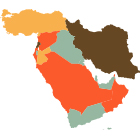Stakeholder Mapping and Analysis for Water Sector in Lebanon - SDC
Background:
The Stakeholder Mapping and Analysis for Lebanon’s Water Sector project emerged to address pressing challenges and opportunities. It sought to shift from pure humanitarian efforts to comprehensive development initiatives, aligning with Sustainable Development Goal 6 (SDG 6) and the humanitarian-development-peace building nexus under SDG 16. Being a small middle-income country, Lebanon has grappled with regional conflicts and received refugees from various crises, making it the world’s highest per capita refugee host. The Syria crisis added pressure, straining resources and intensifying water access issues.
The Lebanon Crisis Response Plan (LCRP) 2017-2020 aimed to transition from humanitarian aid to sustainable development. It focused on extending water, sanitation, and hygiene services to vulnerable communities and addressing environmental concerns. Lebanon’s economic challenges, marked by fiscal deficits and debt, hindered infrastructure investments, affecting water services. Further crises, including the Beirut explosion and the COVID-19 pandemic, worsened vulnerabilities. The water sector operates under Law 221, promoting Integrated Water Resources Management and private sector collaboration. The National Water Sector Strategy (NWSS) addressed governance, climate change, and infrastructure.
Lebanon’s water resources faced stress, with pollution and inadequate infrastructure. Despite improvements, challenges persisted, warranting Swiss Cooperation Programme Middle East 2019-2022 (SCP) support. The project leveraged Swiss expertise to support Lebanon’s transition from humanitarian to development initiatives. It aimed to inform SDC’s future interventions in the crowded donor landscape, considering the prevailing challenges and opportunities.
Triangle’s Assignment:
- Context Analysis: The study commenced with a comprehensive context analysis of the water sector in Lebanon. This involved reviewing existing studies and summarizing key findings from relevant documents. This foundational step was crucial for understanding the state of Lebanon’s water resources, challenges, and opportunities at that time.
- Stakeholder Mapping: A significant aspect of this project involved mapping and analyzing the various stakeholders within Lebanon’s water sector. This included government bodies, private sector entities, interest groups, and NGOs, among others. Understanding their visions, missions, influence, interests, and power positions was essential for shaping future interventions effectively.
- Power Dynamics: An essential element of the analysis was assessing how key stakeholders benefited from ongoing and potential future interventions in the water sector. This included examining their support or opposition to these interventions and identifying areas where collaboration or advocacy was needed.
- Risk and Opportunity Assessment: The study delved into identifying risks and opportunities within the water sector, considering various scenarios related to climate change, politics, demographics, and socio-economics. This step aimed to provide a forward-looking perspective on the sector’s development and potential challenges at that time.
- Swiss Cooperation Engagement: The assessment evaluated the Swiss Development Cooperation’s (SDC) current and past engagements in Lebanon’s water sector. It sought to identify SDC’s comparative advantages and the strategic implications of its involvement, aligning with SDC’s global goals related to water, sanitation, and peace as of the study period.
- Strategic Options: Based on the analysis conducted, the study presented strategic options for SDC’s engagement in the water sector. These options encompassed objectives and intervention strategies at macro, meso, and micro levels, considering the triple nexus of humanitarian aid, development, and conflict prevention during the study period.
- Conclusion and Recommendations: The study concluded by consolidating its findings and providing recommendations for SDC’s portfolio in Lebanon’s water sector at that time. This included confirming existing engagements and identifying new areas of intervention, considering budget constraints and potential additional funding, based on the circumstances and insights available during the study period.
Project:
Stakeholder Mapping and Analysis for Water Sector in Lebanon – SDC

Duration:
May 2022 – July 2022
Lebanon
